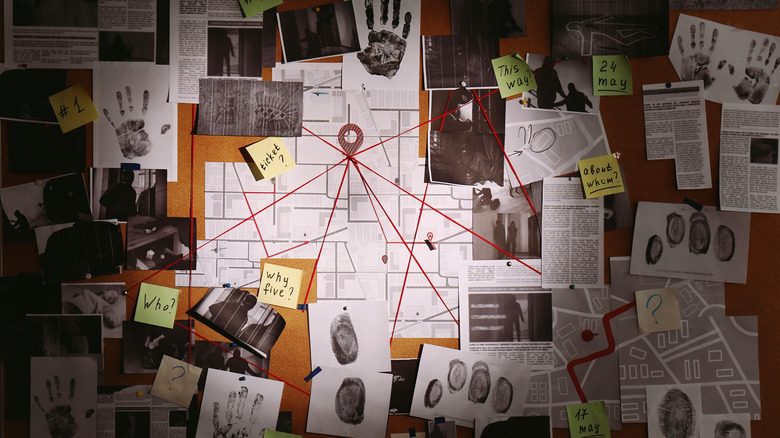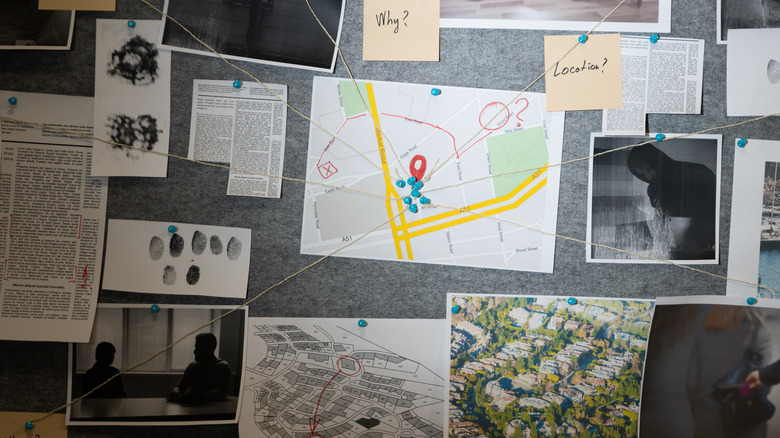The History Of The Doe Network Explained
Unlike fictional detectives Hercule Poirot, Sherlock Holmes, and Father Brown, missing person cases are rarely solved by one crime-fighting brainiac. Real-life crime-solving is a group effort, many people offering their unique skill sets, time, and grunt-work. More than 17,000 missing person cases and 13,000 unidentified body cases remain open in the United States as of 2022. However, recently, missing person cases have decreased due to better communication and tracking (per World Population Review).
Assisting with these efforts is the Doe Network. The volunteer-run organization investigates cold cases, identifying missing and unidentified persons. Their mission is "to give the nameless back their names and return the missing to their families" (per The Doe Network). Their start in 1999 coincided with the rise of online forums and databases. Jennifer Marra initially ran the site and later collaborated with amateur sleuth Todd Matthews's Yahoo Cold Case Group (via Inside Hook). As of now, the network has solved or assisted at least 109 cases. Members use their unique skillsets to dig up information and share it with the group (via The Doe Network).
For example, Bobby Lingoes is a civilian database manager for the police in Quincy, Massachusetts. When volunteering for the Doe Network, he searches the FBI's databases for relevant information (per The New York Times). The network also accepts and documents tips, putting all the information about a case into one place. The information gathered by the group varies from dental records to police reports, photographs, and DNA, as the Associated Press reported in 2008 (posted by the Seattle PI).
How it works
Todd Matthews, an early member of the Doe Network, explained to NPR in 2008 that a lot of the group's data comes from news reports of missing persons or unidentified bodies. The network validates and reconfirms the data with local law enforcement. Matthews calls the group's work "technocriminology," providing exposure to cases with the hope that law enforcement, the media, and private citizens will make connections between the missing and the unidentified (via NPR).
If a volunteer has a hunch or a lead matching a missing person to a Doe, they bring the information to the group's online forum. A committee puts the data through a strict vetting process, ensuring a precise match. Only then will a group director reach out to local authorities with the tip, explains Tracie Fleischhut, a New York State Doe Network director, (per The New York Times). Additionally, members are checked for credibility as thoroughly as the data (via NPR).
This strict vetting process has given the group credence among some investigating agencies, reports The New York Times. Ralph Taylor, chairman of the criminal justice department at Temple University in Philadelphia, explains: "In the late 1960s and early '70s, the police realized they were understaffed, so they began to rely on community groups to be their eyes and ears to help prevent crimes before they happened. ... These Internet groups are an extension of that, supplementing investigations of crimes after they take place" (New York Times).
A much-needed resource
Citizen groups like The Doe Network offer investigating agencies a valuable resource: their time. Network member Todd Matthews tells NPR that many of the group's volunteers spend 40-60 hours each week — on top of their day jobs — chasing data trails and possible matches. He suggests that recreating this human power in an official agency would be impossible due to the cost: "You have to tap into the volunteer nature of people," he says (via NPR).
Robert McCrie, a professor of police science at John Jay College of Criminal Justice in New York, agrees (per The New York Times). He explains that amateur organizations like the Doe Network are a significant help to missing and unidentified person cases: "Law enforcement's too important to be left up to the police. ... These amateur sleuths have a lot to offer, as well. We've seen TV programs help solve crimes. These databases dispersed though the Internet can accomplish the same thing" (via The New York Times).
Even though the network supplements the official work of investigating agencies, Doe Network members have invested in streamlining government information-sharing infrastructure. Matthews served on the task force to create the National Missing and Unidentified Persons System (NamUs) (per the Associated Press, posted by the Seattle PI). NamUs is an online database for investigating agencies to share and search information about missing and unidentified persons.
Closing cases is bittersweet
Working for the Doe Network is far from typical data analysis. The facts, photos, and stories are deeply human and often tragic. Once the organization finds a match and a case is solved, even the resolution is bittersweet, explains Doe Network member Kaylen Johnson to the Associated Press. She says, "On the one hand, you are giving families the information they have been searching for. On the other, you are extinguishing all hope that their missing loved one will be found alive."
Johnson offered an example of her first-hand experience with a network success story. A woman from Kentucky reached out, searching for her husband, who had been missing for 18 years. The woman informed the network's members that her husband had a tattoo on his shoulder with the initial RGJ. Volunteers found her husband, a John Doe in Vermont, by identifying the tattoo. Johnson remembers sharing the news with the Kentucky woman and the strange feeling of being thanked after she informed the woman that her husband had been murdered. Relief and gratitude are common reactions to Doe Network conclusions. Mary Weir explains, "Nothing you find can be any worse than something that has already gone through your mind." The Doe Network identified her daughter's remains.
A Doe Network resolution: Deanna Lee Criswell
The case of Deanna Lee Criswell demonstrates the Doe Network's power to give closure to missing person cases. In 1987, Deanna Lee Criswell boarded a bus from Spokane, Washington, to Arizona, reports KXLY (posted at The Doe Network). Deanna's sister Debbie Renn remembers, "Her boyfriend Bill had sent her a bus ticket and she was going to go to Arizona and live with him." Criswell was just 16 at the time. The last time they heard from her, she called to tell them she was safe. Renn laments, "I was so hoping I would be able to see her again someday. That we would find her alive and well somewhere." They waited 28 years with no new information.
In 2014, Criswell's uncle started searching, using the Doe Network. Within 10 months, he found a reconstructed photo unidentified person that matched. Renn tells KLXY, "we all looked at it and it was pretty much undeniably her." Soon after, DNA confirmed it was Criswell. The family learned that her boyfriend, William "Bill" Knight, had shot and killed Criswell in 1987.
Renn said of the new information, "Now that we know she's gone, we know that it's not because she didn't like us anymore that she didn't call us. It's because she couldn't call us" (per KXLY). As is the case for many families who receive confirmation from the Doe Network about their missing loved ones, the grim news brought relief.
The reasons they search
Doe Network members have compelling reasons for undertaking the often-tedious and reliably gut-wrenching work of data collection and chasing leads about missing and unidentified persons. According to a 2004 report in The New York Times, former paralegal Carol Cielecki stumbled into her role as a Doe Network sleuth. Her journey began in a search for her missing ex-husband.
Her ex-husband, who had a pattern of sudden disappearances, had been last seen abruptly selling his motorcycle for well below its value. Due to his habit of unexplained absences, Cielecki didn't worry. But after years, she began to search for him. While she has yet to locate her husband, she has devoted her time to helping others find their loved ones. She tells The New York Times, "'I think I owe it to my daughter to find him, to find answers for her. ... In the meantime, there are people out there looking for help that don't know where to turn."
Early Doe Network member Todd Matthews is motivated by a pre-Doe Network case he helped solve, "Tent Girl." He learned about the case from his father-in-law, who discovered the remains. Matthews spent a decade working on his own, eventually connecting with the missing woman's sister and identifying her as Barbara Ann Hackman-Taylor (via the Associated Press). "I found my niche in life," Matthews said.





